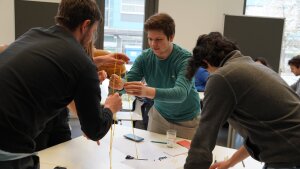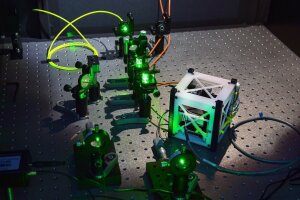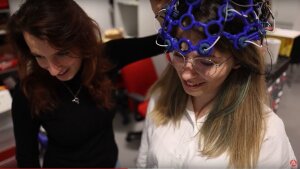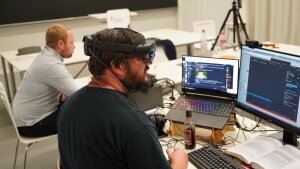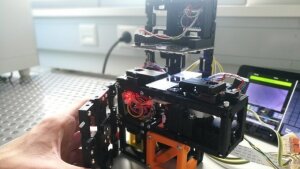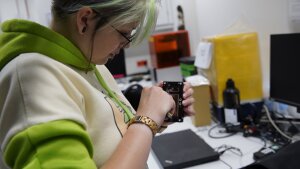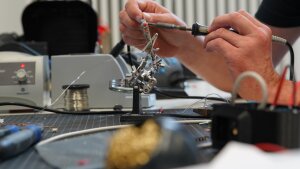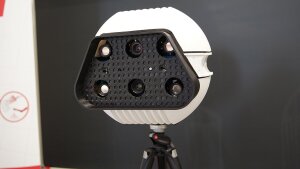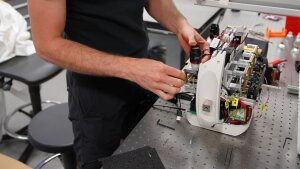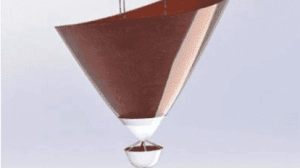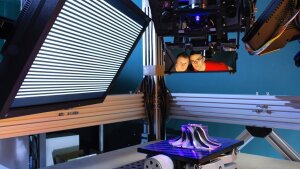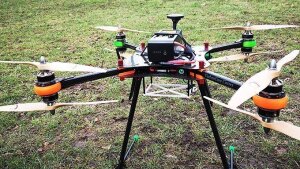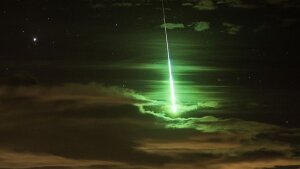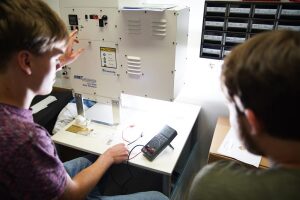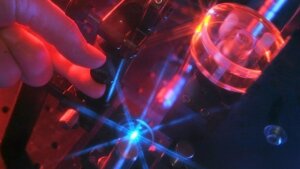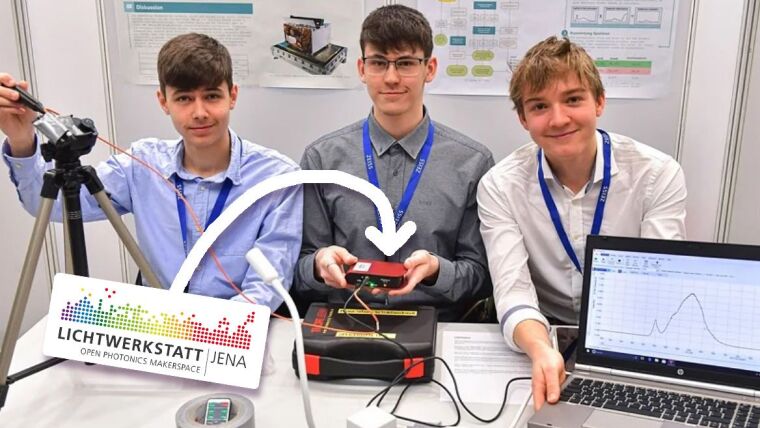
Lichtwerkstatt Design Thinking Workshop 2023.
Image: David Zakoth, Uni JenaStart Your Own Project Today!
The Lichtwerktatt Makerspace is a place where ideas become transformed into the physical space. Come by and use all of our equipment to build your idea, to experiment with materials, or to learn something new!
Quantum Mini Labs: Single Photon Sources (2025)
Prototype of a quantum light source, researched in cooperation between the Vogl and Eilenberger groups.
Image: Jürgen Scheere (University of Jena)The Quantum Mini Labs are compact, user-friendly experimental setups designed to introduce the fundamentals of quantum technologies to students and researchers. They enable hands-on exploration of key quantum phenomena, such as superposition, entanglement, and quantum interference, making advanced concepts accessible through intuitive, interactive learning experiences. These portable labs are ideal for classroom demonstrations, workshops, and outreach events, fostering curiosity and engagement in the rapidly evolving field of quantum science. In our Lichtwerkstatt, we are working on how they can also be equipped with single-photon sources to demonstrate core quantum effects with real quantum light.
Brain-Computer-Interface (2025)
A student project on a Brain-Computer-Interface developed in the Lichtwerkstatt Makerspace.
Image: Bundesagentur für Arbeit.A Brain-Computer Interface (BCI) allows direct communication between the brain and external devices by detecting brain signals, usually through sensors placed on the scalp. These signals are then processed by algorithms to translate neural activity into commands that can control computers, prosthetics, or other technologies. BCIs work by detecting specific brain wave patterns and converting them into digital inputs, enabling users to interact with technology using their thoughts. In our Lichtwerkstatt, we are offering workshops to explore the potential of reading out your own bio- and brain signals - stay tuned!
AR/VR Digital Teaching Lab (2024)
AR/VR workshop by the Lichtwerkstatt Makerspace.
Image: Sabine Best, Uni JenaIn cooperation with the Max Planck School of Photonics, the Lichtwerkstatt is developing digital teaching content with virtual reality (VR) and augmented reality (AR). For example, we are testing how laboratories can be enriched as real environments with digital information (AR) or how students can experience and learn the basics of experimental setup in the laboratory completely virtually (VR). In addition to the latest AR and VR glasses and powerful computers, the Lichtwerkstatt also has access to high-quality camera and recording technology for development and implementation. www.maxplanckschools.deExternal link
Open UC2 – Open Source Optics Toolbox (2024)
Self-made smartphone microscope from Open UC2 and the Lichtwerkstatt.
Image: Benedict DiederichThe UC2 project is creating an open-source, modular system that can be easily adapted to the user’s specific requirements. For example, optical and microscopy systems can be designed with ease. Production costs are low, as the individual components are manufactured using 3D printing or inexpensive, readily available mechano-electro-optical components are used. Image acquisition and processing are realized by ubiquitous systems such as smartphones or Raspberry Pi and deliver high-resolution results. 2022 the team founded a company to push open source microscopy even further. www.openuc2.com/External link
Aura Optik - Laser Material Processing (2023)
Laser Cutting workshop in the Lichtwerkstatt Makerspace.
Image: David Zakoth, Uni JenaThe Jena-based company aura optik studied the effect of focused laser light on various materials in the light workshop. The experimental approach consists of using a green laser pulsed in the nanosecond range and applying single (or a few) pulses to the samples. The samples are then examined by light microscopy and electron microscopy. The aim of this study is to find new approaches to microstructuring with lasers.
maQuer.SPACE: Single Photon Detector (2022)
Bike sensor project in the Lichtwerkstatt Jena.
Image: Sabine Best, Uni Erfurt.The BMBF-funded research project “maQuer.SPACE” has been working closely with the Lichtwerkstatt to develop practical experiments on quantum photonics and teaching materials for the interested public. The aim was to bring quantum technologies closer to as many people as possible and make them understandable. The challenge for the team is to construct the components in such a way that an experimental setup can be replicated at home or in the classroom using inexpensive materials and typical tools in a DIY manner. The single photon detector based on an electrically operated avalanche photodiode is currently being developed by dedicated makers in the light workshop. They not only have low-cost, high-intensity and robust single-photon sources at their disposal, but also low-cost control electronics for the self-assembly of single-photon detectors.
NeoVital - Optical Sensor for Vital Sign Detection (2022)
NeoVital – an Optical Sensor for vital sign detection developed in the Lichtwerkstatt.
Image: Dr. Jan SperrhakeThe project NeoVital has been developing a sensor that uses nano-optical filters and 3D measurement technology to record the vital parameters of newborn babies, for example. Heart rate, blood oxygen content or respiratory volume can thus be monitored wirelessly. Researchers from Friedrich Schiller University Jena, Ilmenau University of Technology and Jena University Hospital are working on the project together with Steinbeis Qualitätssicherung und Bildverarbeitung GmbH. Parts of the prototype are being developed in the Jena Light Workshop. For example, the 3D printers are used to build the housing. In 2020, the project channeled into a Jena-based start-up and was awarded several prizes for innovation and entrepreneurship.
Robot platform (2022)
Setting up of the a lab robot in the Lichtwerkstatt Makerspace.
Image: Canan Gallitschke, Uni JenaPhysical computing is simply more fun than dry programming on a computer. The aim of the student project is therefore to develop a moving robot platform that can be connected to a variety of sensors. It is controlled via Raspberry Pi, which can be easily configured for the respective control and communication tasks. A self-propelled robot is the hardware basis. The platform is suitable both for beginners to learn how to program graphical programming languages and for experienced programmers to implement unusual sensors or actuators and work on more complex problems.
www.schueler-roboter.deExternal link
Calisto - Lighting and Sound System (2021)
Lichtwerkstatt Calisto Project.
Picture: Eric Huget, TU DresdenCalisto is a new type of integrated lighting and loudspeaker system with gesture-controlled operation. To this end, the Lichtwerkstatt was researching the use of suitable optical 3D sensor technology and developing customized evaluation software that supplements and simplifies 3D gesture control with context-related information. A central role in the concept is played by the targeted modeling of the lighting function with a planar radiation inspired by the sun.
3D Measuring System (2021)
3D Sensor System, created in the Lichtwerkstatt together with our partner Fraunhofer IOF.
Image: Fraunhofer IOFOur collaboration partner Fraunhofer IOF developed an easily accessible development kit for flexible low-cost 3D sensor technology with pattern projection in the Jena Light Workshop. The scientists are supporting the maker community in applying this kit in innovative prototypes. Commercially available systems such as cell phones or tablets are used as a carrier platform for data acquisition and utilization. The necessary software is made available to the maker community for use and further development via the respective app stores.
www.iof.fraunhofer.deExternal link
3D Scanning Racing Drone (2020)
3D Scanning Racing-Drone built in the Lichtwerkstatt Makerspace.
Image: Johannes Kretzschmar, Uni JenaUsing structure-for-motion calculations in photogrammetry, object dimensions and 3D models can be created from ordinary video footage. To record the video material, large drones with GPS control usually fly over an easily accessible area. A project in the Light Workshop is investigating photogrammetry applications of small and agile FPV racing drones that carry a 360° camera. The special remote control concept makes it possible to navigate through areas that are difficult to access and unsuitable for GPS, of which a true-to-scale 3D model can then be calculated.
Cellerime Medical Drone (2020)
Celerrime Medical Drone
Image: Lichtwerkstatt Jena, Max Hausmann.Celerrime is a fully functional drone that can be modularly adapted to different areas of application and can carry transport material and measurement technology. By combining modern sensor technology and artificial intelligence, the drone is intended to be used both by rescue teams in the search for and initial treatment of accident victims and as a high-altitude research platform for specific measurements.
Raman Spectrometer (2020)
Do-it-yourself Raman spectrometer project in the Lichtwerkstatt.
Image: Sabine Best, Uni Erfurt.In the innovation project supported by Fraunhofer IOF, fully documented instructions for the construction of a Raman spectrometer are being developed. The main challenge is that all individual parts are either readily available commercially or can be reproduced using 3D printing or other established manufacturing techniques. The aim is to produce a portable and cost-effective instrument that is suitable for simple measurement tasks.
Meteorite Camera (2019)
Impression of a meteor crossing the atmosphere.
Picture: Berliner MorgenpostIn order to be able to calculate the trajectory of meteorites from image data, a network of several cameras is required that observe and record the night sky from different locations. The cameras must not only be weatherproof, but also have GPS, algorithms for image recognition or a data upload function. The aim of the project is to design a camera that meets all practical requirements and can be easily replicated in order to expand the network in the spirit of citizen science. The project is being developed in collaboration with abantu Kulturlabor Jena. And the project is a winner of the “Jugend forscht – Schüler experimentieren 2019” competition.
www.kulturlabor-jena.spaceExternal link
Single Pixel Camera (2019)
Single-pixel camera operated in the Lichtwerkstatt Makerspace.
Image: Jan-Peter Kasper (University of Jena)The aim of the project is to demonstrate alternative imaging systems with applications in hyperspectral imaging and 3D measurement. To this end, the team is analyzing various concepts of single-pixel cameras and supplementing them with detectors for exotic wavelengths, multispectral sensors and even complete spectrometers. A conventional scanner is used for the imaging system, which is enhanced with DMD array systems and compressed sensing methods. The team is receiving funding for the implementation from the Fraunhofer IOF.
Solar Cells made of Plant Dyes (2019)
Lichtwerkstatt - testing solar cells made of plant dyes.
Image: Reinhard Geiss, Uni JenaIn the “Jugend forscht” project, students from Weimar are investigating the behavior of so-called Grätzel cells – solar cells that can be produced from plant dyes (antocyanins). To do this, hibiscus flowers are carefully boiled and processed. The self-produced cells are then professionally examined in the Jena Light Workshop using a solar simulator, which provides the same light output and spectrum as the sun. The project is supervised by the Gera Student Research Center.
www.jungforscher-thueringen.de/sfz/geraExternal link
Hands-on Innovation Projects with Mainz (2019)
In the “Hands-on Innovation” collaboration course together with the Mainz University of Applied Sciences, the Lichtwerkstatt Jena has developed a number of projects for replication. The project manuals are available in the German language and can be downloaded here.
- Project - Alkoholtester to gopdf, 1 mb · de
- Project - Demenzsensorpdf, 626 kb · de
- Project - DIY-Mikroskope (UC2)External linkde
- Project - GoPiGo Bauanleitungpdf, 1 mb · de
- Project - Health Monitoringpdf, 2 mb · de
- Project - KaffeeLiegerBotpdf, 1 mb · de
- Project - Kohlemonoxid-Lampepdf, 2 mb · de
- Project - LED-Tischpdf, 942 kb · de
- Project - Lego-Mobilpdf, 782 kb · de
- Project - SafeToGopdf, 2 mb · de
- Project - Spielekonsolepdf, 1 mb · de
- Project - Zahnputzhilfepdf, 1 mb · de
Smartphone Lithography (2018)
Smartphone lithography project conducted in the Lichtwerkstatt Makerspace.
Image: Reinhard Geiss, Uni JenaIn this project, high-resolution smartphone displays are used to selectively expose a resist layer in order to enable cost-effective and portable access for the production of circuit boards, micro-optics and microfluidic structures, for example. The necessary peripherals, in particular a resist spinner, are integrated to produce the resist layers with a homogeneous thickness. The team is investigating various polymers for their suitability as resists during the project supported by the Fraunhofer IOF.
